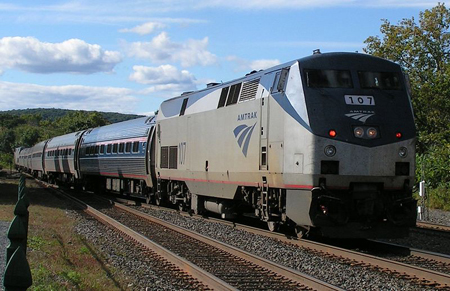Happening Now
Back to the Future
March 10, 2014
Written By Colin Leach

Amtrak's Vermonter at Palmer, Massachusetts. Photo from Wikimedia Foundation
Regular readers of our blog will know that we’ve reported to you about the rekindling of our nation’s interest in passenger rail. Frustrated by fewer flights to small and mid-sized communities and clogged highways, Americans from coast to coast understand that trains are a fast, comfortable, safe, and stress-free way to travel. Stories from places such as Michigan, Oklahoma, and Virginiashow that critics’ assertion that passenger rail is only viable in the Northeast Corridor simply isn’t true. Every day, more and more Americans in communities big and small, urban and rural, climb aboard.
But don’t just take our word for it. Behind each story of increased interest in and support for passenger trains lies a change in mentality that will force policymakers to reconsider America’s transportation policies. In a report released today, the American Public Transportation Association (APTA) found that, in 2013, Americans made 10.7 billion trips on public transportation systems, including commuter rail, light rail, and public buses. That’s the most trips made on transit systems since 1956! (ironically the year that the Federal Aid Highway Act was passed). From this data, we can conclude that, as APTA CEO Michael Melaniphy did, that “there is a fundamental shift going on in the way we move about our communities.” Now more than ever, Melaniphy noted, “public transportation investment drives community growth and economic revitalization.”
Rail advocates can be delighted that much of this growth is on rail-based systems. Nationwide, ridership on commuter rail systems grew by 2.1% in 2013, and light rail ridership grow by 1.6%. Commuter bus ridership remained largely stagnant, decreasing by 0.1%. As might be expected, much of this growth occurred in cities that have made substantial investments in building new rail systems. In Texas, patronage of Austin’s Capital MetroRail and Denton County’s A-Train increased by 37.3% and 23.0% respectively. Here, we can attribute the increase to local authorities’ decisions to invest heavily in the acquisition of faster and more efficient trains, lowering operational costs and offering more options to commuters.
Similar investment in Pennsylvania precipitated a 33.8% increase in ridership on Amtrak’s Keystone Service between Philadelphia and Harrisburg. Pennsylvania’s investment in the service has not only allowed the service to continue after PRIIA Section 209 came into force, but also allowed planners to contemplate expanded, faster service in the future. With the Keystone Service, we find yet another example of passenger rail’s place in the larger transportation network. Amtrak is by no means an occasional service for those who want to go on a weekend journey, rather, it moves Americans to and from work and home each and every day.
APTA’s release of its findings couldn’t come at a better time. On February 26th in St. Paul, Minnesota, President Obama outlined his proposal for $19 billion in investment in passenger rail over the next four years. Combined with another $72 billion slated for other transit projects, the President’s proposal is a substantial investment in the transportation network Americans want, and, as the APTA findings show, already use.
In many ways, policymakers’ newfound interest and travelers’ embrace of passenger rail represents a return to proven principles of American urban planning. In the decades prior to the introduction of personal cars, many Americans relied on trains every day to travel to work. Whether they lived in smaller rural communities or the so-called “streetcar suburbs”, Americans could take advantage of a robust, interconnected network of long-distance and regional trains, as well as interurbans and streetcars, to make their journeys.
In later years, however, this network was eroded and undermined by competition from subsidized highways and aviation. While we would not dispute that federal investment in other modes was (and still is) necessary, the pendulum has swung too far in the other direction. As a result, in addition to disappearing air service, Americans must also acknowledge that our highway network lacks a sustainable funding source. The cure for our coming transportation crisis rests in recognition of all modes- road, air, and rail -as part of a balanced transportation network. For rail, that means investment in proven service models that we know efficiently serve all types of communities.
APTA’s data confirm what advocates have long known. When given a choice between cars and a comprehensive transit network, Americans readily embrace transit. Policymakers have also recognized this, and have begun to call for increased investment in transit. You can count on NARP to continue our tireless advocacy for increased investment in and support of a passenger train network that, in many ways, is truly “back to the future”.
"We would not be in the position we’re in if it weren’t for the advocacy of so many of you, over a long period of time, who have believed in passenger rail, and believe that passenger rail should really be a part of America’s intermodal transportation system."
Secretary Ray LaHood, U.S. Department of Transportation
2011 Spring Council Meeting
Comments